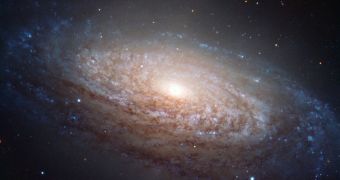Astronomers at the European Southern Observatory (ESO) recently captured an amazing view of the spiral galaxy NGC 3521. The massive cosmic structure is located about 35,000 light-years away, in the direction of the constellation Leo.
For this investigation, experts used the ESO Very Large Telescope (VLT), at the Cerro Paranal Observatory, in Chile. This instrument is unparalleled in its ability to use optical interferometry for capturing highly-detailed view of distant cosmic objects.
Optical interferometry is an astronomical imaging technique that combines light captured by multiple optical observatories into a single, coherent image. The VLT installation features four such telescopes.
NGC 3521 has a diameter of about 50,000 light-years, which makes it less than half the size of the Milky Way. One of the features that immediately stands out about the structure is its bright, extremely compact nucleus.
This region is surrounded by an intricate spiral structure, which the VLT was able to photograph at a high resolution level. Astronomers found that the galaxy's arm are very long, featuring patchy areas of intense stellar formation.
Large veins of dust can also be identified in the photo. Overall, NGC 3521 is classified as a flocculent spiral galaxy, which means that it features a patchy appearance. About 30 percent of all spiral galaxies discovered so far are flocculent.
The fact that this particular cosmic structure is bright and relatively near-by in astronomical terms makes it a prime target for study, from both professional and amateur astronomers and skywatchers.
The VLT managed to identify colorful features in the spiral arms of NGC 3521. For instance, it observed redder, older stars in close proximity to the galactic core, and younger, blue star farther away towards the edge.
ESO astronomers created this image from data collected through three filters – blue light (colored blue), yellow/green light (colored green), and near-infrared light (colored red). The data were first identified by ESO Hidden Treasures 2010 competition contestant Oleg Maliy.
“The total exposure times [for this view] were 300 seconds per filter. Oleg’s image of NGC 3521 was a highly ranked entry in the competition, which attracted almost 100 entries,” ESO says in a press release.

 14 DAY TRIAL //
14 DAY TRIAL //